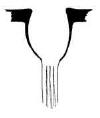|
|
 |
Various shapes of amphid apertures. More convoluted shapes are thought to enhance sensitivity as chemoreceptors. |
| From Shuurmans-Stekhoven and De Coninck, modified by Maggenti, 1981. | |
 |
|
Nematodes have a variety of sensilla:
(i) Amphids
|
|
 |
Various shapes of amphid apertures. More convoluted shapes are thought to enhance sensitivity as chemoreceptors. |
| From Shuurmans-Stekhoven and De Coninck, modified by Maggenti, 1981. | |
 |
|
(ii) Phasmids
pore-like phasmid in lateral field of Rotylenchus robustus
(photomicrograph by I.A. Zasada).
(iii) Other Sensilla
|
 |
|
|
|
|
|
|
|
|
|
 |
|
|
| Adapted Maggenti, 1981 and Hirschmann, 1960. | |
Return to Phylum Nematoda Menu